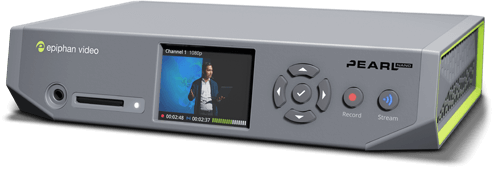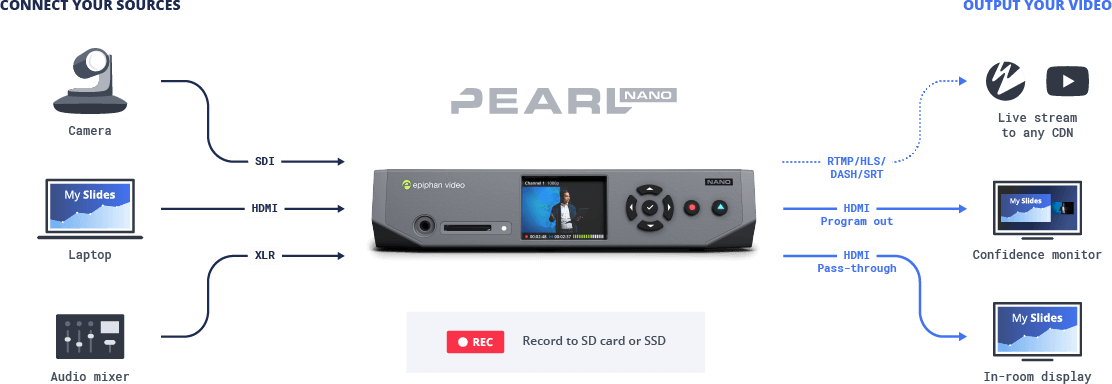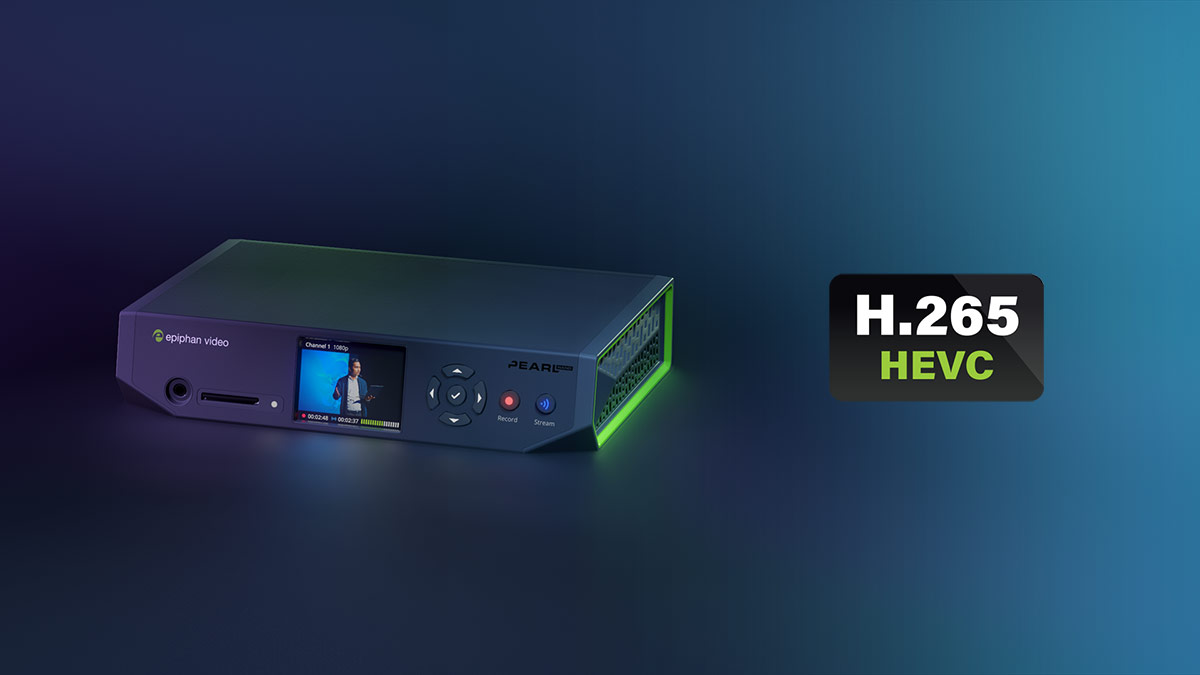Also known as H.265, High Efficiency Video Coding (HEVC) halves video file sizes and the bandwidth needed to stream them compared to H.264, or Advanced Video Coding (AVC) – without compromising on video quality.
It probably seems like a no-brainer to choose H.265/HEVC over H.264/AVC for your next project. Trouble is, you’ll need an HEVC-capable encoder to take advantage of this powerful video codec (as well as an H.265-compatible content delivery network).
So, what’s the best HEVC encoder you can buy? Read on to discover six compelling reasons to consider the award-winning Pearl Nano video production system for your HEVC encoding needs.

H.264 vs. H.265: Video codecs compared
Read more
Get the best HEVC encoder out there
The Epiphan Pearl Nano video production system offers serious power in a compact package, capable of encoding H.265/HEVC video and empowering you to upgrade your system with 4K streaming and recording capabilities.
Discover Pearl Nano1. Pearl Nano is powerful
“Small but mighty” perfectly describes Pearl Nano. In a compact form factor, Pearl Nano packs some serious power – enough to convert video with H.265/HEVC as well as record and stream in 4K with an optional feature add-on.
If you’re only looking for an HEVC encoder to halve the size of HD videos (i.e., 720p, 1080p), Pearl Nano fits the bill. But it’s when you combine the power of the H.265 format with 4K that the potential of this codec becomes fully apparent. With H.264/AVC, 4K video comes out at 32 Mbps. With H.265, it’s just 15 Mbps, and that smaller size doesn’t come with a hit to quality. Ultimately, H.265 makes 4K much more practical for video recording and live event production.
2. Pearl Nano is ultraportable
One of Pearl Nano’s biggest advantages is also the most apparent. This device is small, measuring just 206 mm x 150 mm x 43 mm and weighing only 907 g. That’s small enough to carry in a backpack, ship out to a remote contributor, or use in situations where table space is scant.
Adding to the portability factor is Power over Ethernet Plus (PoE+). PoE+ is exactly what it sounds like – a way to send power to your device through an Ethernet cable, along with any data. (Wondering about the “plus”? It’s there because PoE+ can send up to 25.5 watts of power, versus the 12.95 watts regular PoE can.)
Ultimately, PoE+ means one less cable and power adapter to worry about. That might not sound like much. But it can make a big difference when it comes to portability, as well as when you have cameras, computers, projectors, and other devices competing for limited outlets.
3. Pearl Nano is intuitive
Not only is Pearl Nano powerful and portable, but it’s also a cinch to set up and use. Features like PoE+ and the built-in HDMI and SDI ports speed up setup considerably. Then, the built-in front screen offers easy access to basic configuration and control options. Or you can access the full list of features through Pearl Nano’s browser-based interface, which is just as user friendly.
The front screen also doubles as a confidence monitor. With just a glance at it, you can verify that your video and audio sources are coming in – perfect for production peace of mind.
4. Pearl Nano is versatile
Along with supporting both H.265/HEVC and H.264/AVC video encoding, Pearl Nano offers flexibility in other ways:
- The system features built-in video inputs for both HDMI and SDI (the standard in broadcasting).
- It supports a range of streaming protocols. This includes traditional options like RTMP and RTMPS, and more modern ones like Secure Reliable Transport (SRT), HTTP Live Streaming (HLS), and Dynamic Adaptive Streaming over HTTP (DASH).
- Pearl Nano can output files in a range of industry-standard video formats including AVI, MOV, MP4, and MPEG-TS.
- You can store your recordings via SD card, a USB drive, local server, or network-attached storage device. You can even add an M.2 SATA SDD to Nano’s expansion bay.

5. Pearl Nano is a content beautifier
Dig into Pearl Nano’s admin panel and you’ll find a powerful custom layout builder. With it, you can create a beautiful composite of your video sources. You can also work in a static or animated background, your company’s logo, on-screen text, and other elements to reinforce your brand and bring a professional feel to your content.
Combine the custom layout builder with Pearl Nano’s optional 4K feature add-on and you can create some truly impressive live and recorded content that will reflect well on your brand.
6. Pearl Nano is remotely accessible and controllable
When you’re producing a live event or recorded content, it’s not always possible to be in the same room as your encoder – or even the same city, country, or continent. Whatever the distance, it’s no problem with Pearl Nano.
Pair Pearl Nano with Epiphan Cloud and you can access, configure, and operate the system from anywhere there’s an Internet connection. You can use every feature you could if you were right there with the device – including H.265/HEVC compression and 4K streaming and recording.
Learn more about Pearl Nano, the best HEVC encoder
There’s a lot more to Pearl Nano than the features we’ve highlighted here. You can discover them on the Pearl Nano product page. For instance, Pearl Nano can encode and decode SRT, making it ideal for remote contribution as well.
If you have any questions about Pearl Nano – or if you’d like to book a one-on-one demo – our product specialists are just an email or a phone call away.
